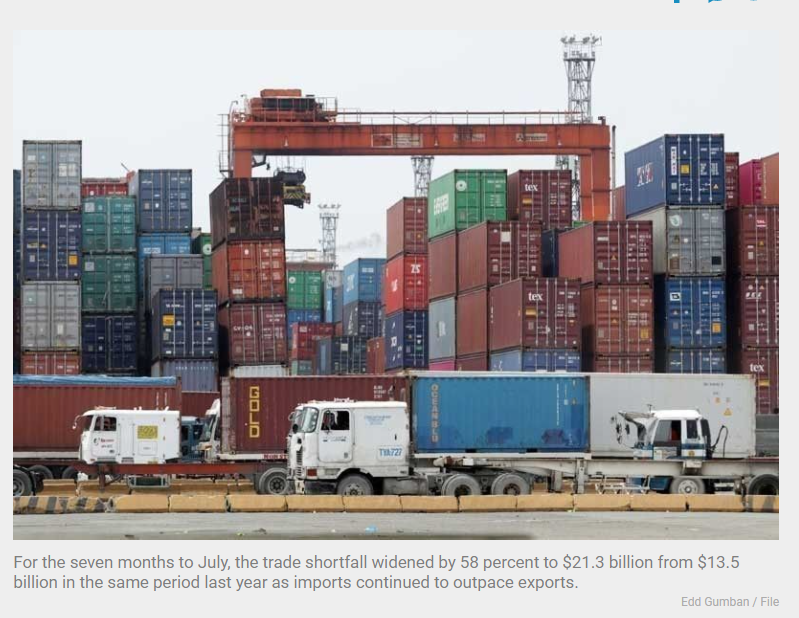Philippines: Trade gap further widens in July as imports surge
MANILA, Philippines — The country’s trade in goods posted a wider gap in July as the reopening of the economy paved the way for a surge in imports, the Philippine Statistics Authority (PSA) said.
The trade shortfall reached $3.29 billion in July, jumping 54 percent from $2.13 billion in the same period last year, but lower than the $3.4 billion gap recorded a month earlier.
The wider deficit was mainly due to the faster 24 percent growth in imports to $9.71 billion in July from $7.83 billion a year ago, reflecting improved economic conditions as the economy slowly reopens.
Export performance also benefited from the reopening of the global economy, registering a growth, albeit slower, of 12.7 percent to $6.42 billion from a year ago.
For the seven months to July, the trade shortfall widened by 58 percent to $21.3 billion from $13.5 billion in the same period last year as imports continued to outpace exports.
As the trade gap approaches pre-pandemic levels, ING Bank senior economist Nicholas Mapa said this suggests sustained weakness of the peso even as latest trade data reflect economic reopening.
“We had previously flagged the likely return of current account deficit for the Philippines this year and today’s trade report solidifies this expectation. As the trade gap approaches pre-COVID-19 levels, we forecast the country’s current account to reverse into deficit as well,” Mapa said.
“Current account deficits coupled with possible portfolio outflows in the coming months due to the (US) Fed taper translates to more pressure on the local currency. With the central bank signaling it will refrain from hiking policy rates this year, it looks like the peso will remain on the back foot to close out 2021,” he said.
Trade figures in July are a reflection of the gradual reopening of the economy and are supported by low base effects, with imports outpacing exports due in part to increased volume of fuel and as crude oil prices rose over the last year.
However, Mapa emphasized that a pullback in trade activity is already expected in August following the third round of lockdown measures and mobility curbs.
“Nonetheless, we forecast import growth to continue to outperform the export sector, with the trade deficit likely staying elevated for the balance of the year,” he said.
Imports for the seven-month period rose by 30 percent to $63.7 billion while exports jumped by 20 percent to $42.4 billion.
For July alone, dollar earnings from electronic products, the country’s top export, increased 10 percent to $3.69 billion.
Other exports showed strength in July, particularly coconut oil, cathodes, ignition wiring sets, other manufactured goods, chemicals, metal components, and electronic equipment.
The country’s top 10 exports, which cornered 83.3 percent of the total, went up 15 percent to $5.35 billion during the month.
The top 10 export destinations of the Philippines also increased by 11.3 percent to $5.4 billion.
Huge growth was seen in exports to Korea, Taiwan, and Thailand. China was the top export destination totaling $1.04 billion or 16.1 percent of total exports.
Rizal Commercial Banking Corp. chief economist Michael Ricafort said faster economic recovery in major export markets could have supported the country’s better rebound but this was offset by lockdowns and restrictions in other markets.
Meanwhile, inbound shipment of goods and services continued to expand, with the sub-sectors of mineral fuels and lubricants, iron and steel, transport equipment, and medicinal and pharmaceutical products leading the growth.
Fuel imports registered an 85 percent increase amid more expensive oil prices in the world market.
China is still the country’s biggest supplier of imported goods at $2.15 billion, about 22.1 percent of the total.
Further, Ricafort said the planned granular lockdowns would help reopen the economy that can lead to pick up in business activities, including manufacturing that could also lead to some improvement in both exports and imports.
“For the coming months, any further pick up in imports and exports would also be a function of more COVID-19 vaccine arrivals and rollouts, especially toward population protection and eventually herd immunity,” he said.
“Increased government spending especially on infrastructure to pump-prime the economy and also in preparations for the elections would lead to a faster pick up in importation of capital equipment, construction materials, and other inputs needed for the various projects,” Ricafort said.
Source: https://www.philstar.com/business/2021/09/10/2126047/trade-gap-further-widens-july-imports-surge


 English
English




